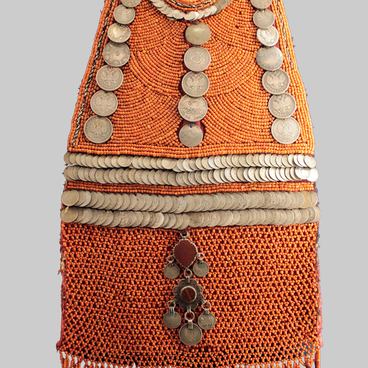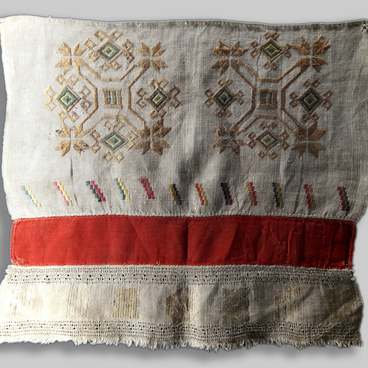The men’s shirt called a kuldek was the same type for all Bashkirs, although its details, and especially the material it was made from, varied significantly. The shirt was always sewn very wide and long, down to the knees or even lower (from 85 to 130 cm long), with a wide, turn-down collar and long, wide sleeves. The collar was tied with a lace but loosely, so that the chest was usually open a few centimeters. The cut was like a tunic, and the shirt was cut from a single piece of fabric, without seams on the shoulders. Wedges were inserted along the sides. The sleeves were straight, and under those square gusset inserts made of homespun fabric were sewn in. The old Bashkir shirt was usually not belted, and was worn untucked.
The monograph by Sergei Ivanovich Rudenko Bashkirs gives the following description: “Men”s shirts were widespread that had a wide, turn-down collar up to 20 centimeters, and with a central vertical slit on the chest. The laces with which the shirt collar was tied were threaded into special loops at the collar, or sewn so that they were fixed. These braided laces usually ended with tassels, and sometimes were distinguished by a special luxuriousness: the laces were wrapped with gold or silver thread, plaited into rosettes, and decorated with multicolored tassels”.
In the 18th century, shirts were sewn from white, undyed linen, and along the edges of the sleeves, along the hem, along the neckline, and on the collar they were covered with embroidered or woven patterns made with red cotton, silk, or woolen threads. Vasiliy Makarovich Cheremshanskiy, in his work A Description of Orenburg Province in Economic, Statistical, Ethnographic, and Industrial Respects from 1859, also notes that sometimes around the slit “different figures from red thread” were embroidered. Gussets and collars of shirts could be made to match the tone of the patterns done with red material.
With very few exceptions, at the beginning of the twentieth century the shirt collar was not embroidered, while in the middle of the nineteenth century embroidery on the collar was commonplace. Sometimes there were shirts with silk embroidery on a turn-down collar. Shirts that were sewn as wedding gifts from newlywed women to their husbands were singularly decorated.
The monograph by Sergei Ivanovich Rudenko Bashkirs gives the following description: “Men”s shirts were widespread that had a wide, turn-down collar up to 20 centimeters, and with a central vertical slit on the chest. The laces with which the shirt collar was tied were threaded into special loops at the collar, or sewn so that they were fixed. These braided laces usually ended with tassels, and sometimes were distinguished by a special luxuriousness: the laces were wrapped with gold or silver thread, plaited into rosettes, and decorated with multicolored tassels”.
In the 18th century, shirts were sewn from white, undyed linen, and along the edges of the sleeves, along the hem, along the neckline, and on the collar they were covered with embroidered or woven patterns made with red cotton, silk, or woolen threads. Vasiliy Makarovich Cheremshanskiy, in his work A Description of Orenburg Province in Economic, Statistical, Ethnographic, and Industrial Respects from 1859, also notes that sometimes around the slit “different figures from red thread” were embroidered. Gussets and collars of shirts could be made to match the tone of the patterns done with red material.
With very few exceptions, at the beginning of the twentieth century the shirt collar was not embroidered, while in the middle of the nineteenth century embroidery on the collar was commonplace. Sometimes there were shirts with silk embroidery on a turn-down collar. Shirts that were sewn as wedding gifts from newlywed women to their husbands were singularly decorated.



